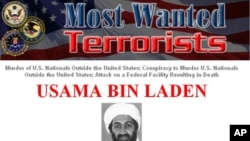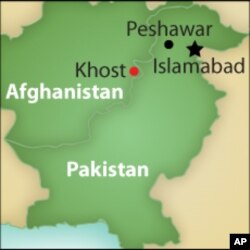In May 1998, Islamabad-based reporter Nafees Takar received a phone call from a man claiming to be linked to a Pakistani militant group.
The man asked to meet Takar, a meeting that set off a chain of events that led to an extraordinary press conference in the mountains of Afghanistan with Osama bin Laden just months before the deadly attacks on two U.S. embassies in East Africa.
Just three years after that, al-Qaida would stage the September 11th attacks in the United States, killing more than 3,000 people.
All Takar was told was he would be taken to cover a major event.
He agreed and joined a group of other journalists who boarded a plane in the Pakistani capital, Islamabad, headed to the city of Peshawar. There, they took another flight to Bannu, a small city near the Afghan border.
The escorted group then boarded a coach to rugged North Waziristan. They were driven further past the capital, Miran Shah, and then, at nightfall, took a perilous, illegal walk across the border into Afghanistan.
Takar says he was never told exactly who he would be meeting, but that during his trip, he and his fellow journalists picked up clues.
Nafees Takar, who is now the head of VOA’s Deewa Radio which broadcasts to the Afghanistan-Pakistan border regions, says the group finally arrived in southern Khost, Afghanistan, where they waited two days to meet the al-Qaida leader Osama bin Laden.
"He was calm, he was humble, he was shy. When he was talking to you, maybe he was shyer, maybe because of Islamic teaching, he was never looking into your eyes. We didn't think at that time that he was very much enthusiatic or he was very emotional. I think those things were not visible on his face, at least."
Listen to the interview with Nafees Takar
He did not come across as the stereotypical hardline Islamic extremist?
"No, he didn't give this impression. He was looking like an ordinary man. And we didn't think he had such a radical mind behind his calm face."
Describe where you were exactly and what it was like.
"You know, when we went to Khost to his bases, we reached the compound late night. And when dawn came, we saw that we are in the middle of the mujahideen, the holy warriors. There were guys marching in the nearby towns, wearing military uniforms. And then the second day, we knew that there were training camps named after the companions of the Prophet of Islam. And most of the guys who were getting training, they were from Pakistan, from the southern districts of Punjab and some were from Pakistan-administered Kashmir."
Image of Nafees Takar's article published in The Nation
"There were three camps there and all of them belonged to Pakistanis. This is the place where we stayed at night and where we waited for at least two days. And then we were taken to another camp, maybe 15 miles away. And there we met Osama bin Laden. That camp was the training camps for Arabs. There were dummy men, there were military exercises, obstacle [courses]. It was surrounded by mountains and the buildings in both places, these were run-down buildings, made of stones and mud, they were very simple houses, rooms and halls, and it didn't give me the impression that these were modern complexes."
It sounds like you were in an al-Qaida training camp.
"At that time, they were not known as al-Qaida, but later after the 1998 East Africa and the 9/11 attacks, I realized that we were with al-Qaida."
At the time in May 1998, had he actually officially told the world that he was leading this organization called al-Qaida?
"He never mentioned that he is the leader of al-Qaida. Only in that press conference, he said that the name that he has given to his affiliates and his group was the 'Islamic International Front,' this is the term he used. I don't know that he himself ever called his organization al-Qaida."
Talk about the message that this seemingly calm, polite man delivered to the group of journalists.
"You know when the formal conversation finished, they took us out of the hall and we sat on the ground, they served us tea and some dry fruit. And at that time, Osama bin Laden was watching us. He was looking to each and every one of us. And Ayman al-Zawahiri [bin Laden's second-in-command] was given a chance to talk about their life, to talk about how they spend their days. But during that press conference, he said that Americans know who killed their troops in Somalia and that Americans know who killed their troops in Saudi Arabia. he was referring to the 1996 attack on U.S. troops in Saudi Arabia. At that time, he didn't say that he killed them, but in a way he was referring to himself that he was probably behind those two attacks."
"One other thing, when he [Osama bin Laden] was mentioning that he was going to start jihad against America and Israel and all the rulers of the Arab world, we thought that he is probably bragging. It was in 1998 and then, again, in 2001 after the 9/11 attacks, I got this impression that I had met the most dangerous man in the world."
Nafees Takar's material from that press conference was published in the Pakistani English newspaper The Nation and also shared with Italian and German news agencies.













